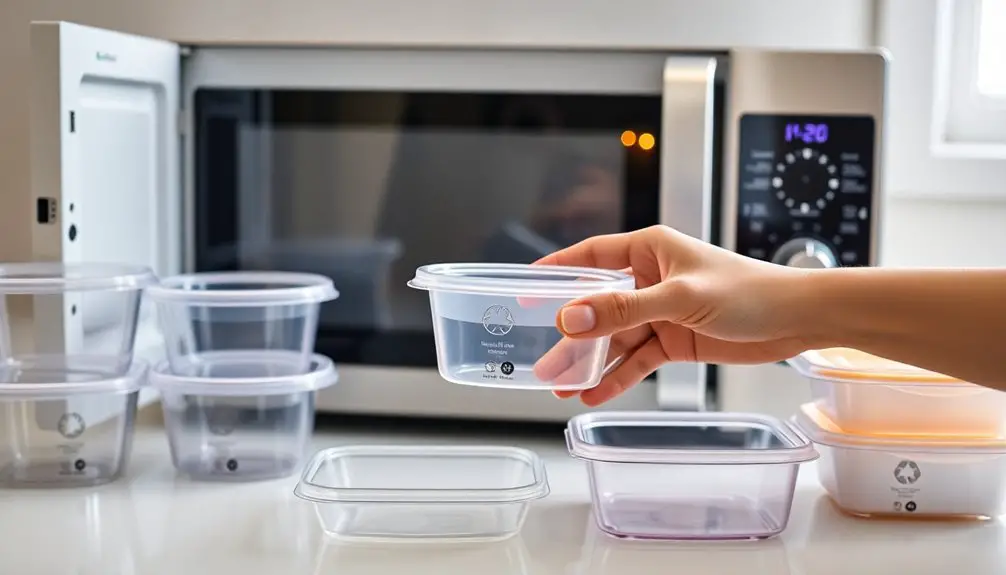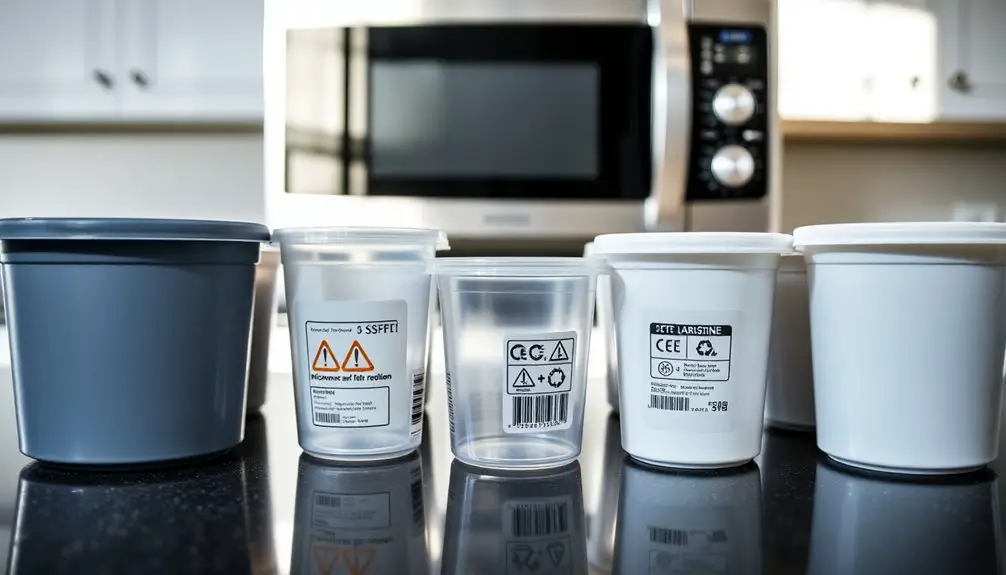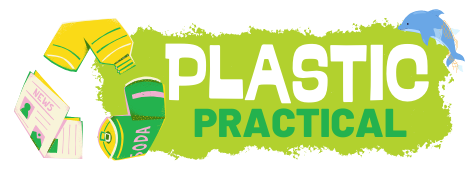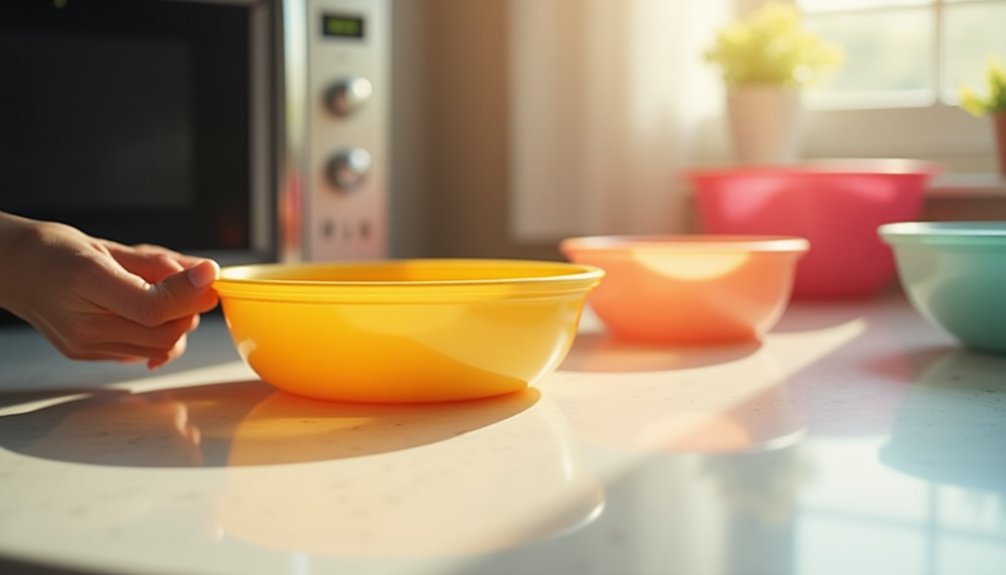To tell if plastic is microwave safe, look for a microwave symbol with wavy lines or "Microwave Safe" text. Plastics labeled #2 (HDPE) and #5 (PP) are generally safe, while #1 (PET) should be opaque. Avoid plastics #4 (LDPE), #6 (PS), and black plastics, as they can release harmful chemicals when heated. Checking for BPA-free and food-grade labels is also crucial. For a quick test, heat water alongside your plastic container; if it cools down without warping, you're likely safe. There's much more about plastics and safe heating options you might want to explore.
Key Takeaways
- Check for a microwave symbol or "Microwave Safe" text on the plastic container.
- Identify the recycling code; #1 (PET) and #5 (PP) are typically safe for microwaving.
- Avoid plastics #3 (PVC), #4 (LDPE), and #6 (PS) as they can leach harmful chemicals when heated.
- Perform the water test: heat water with the plastic; if the plastic cools down, it's safe.
- Look for BPA-free labeling to ensure no harmful leaching occurs during heating.
Identifying Microwave-Safe Plastics
When you need to determine if a plastic container is safe for microwave use, start by looking for specific symbols and labels on the packaging. The most common indicators include a microwave symbol with wavy lines, which suggests it's safe to use. You might also see clear text stating "Microwave Safe." Variations of the symbol exist, but they typically include horizontal wavy lines.
Next, check the plastic number. Generally, plastics #2 (HDPE) and #5 (PP) are safe for microwave use, while #1 (PET) is only safe if it's opaque. Avoid plastics #4 (LDPE), #6 (PS), and any black plastics, as they can release harmful chemicals when heated. Additionally, ensure that the plastic is labeled as microwave safe to confirm its ability to withstand higher temperatures without melting. It's also crucial to be aware of chemical leaching from certain types of plastic, which can pose significant health risks.
BPA-free and food-grade labels are essential as they indicate that the plastic won't leach harmful substances into your food.
Always refer to the manufacturer's guide for specific information on the type of plastic used. By following these steps, you can confidently identify microwave-safe plastics and enjoy your meals without worry.
Understanding Recycling Codes
Understanding recycling codes is crucial for making informed decisions about the plastics you use and dispose of daily. Each plastic item features a recycling code—typically a number inside a triangle—that helps you identify its material and recyclability.
For instance, PET or PETE, marked with a #1, is commonly found in water bottles and food containers, and it's widely accepted by most recycling programs. Not all items with recycling symbols are recyclable, highlighting the importance of checking local guidelines.
HDPE, with a #2 code, is used for items like shampoo bottles but may have limitations on certain products, like plastic bags.
PVC, labeled as #3, is often used in toys and detergent bottles but is usually not recyclable.
LDPE, marked #4, includes grocery bags; recycling options vary by location.
Polypropylene, or #5, is used in food containers and straws, and is recyclable depending on local programs.
Styrofoam, identified as #6, and miscellaneous plastics, labeled #7, are typically not accepted in recycling.
The proper disposal of plastics is essential to reducing plastic pollution and promoting a healthier environment, which is why understanding recycling codes is key to making a positive impact.
Testing for Microwave Safety

Knowing how to interpret recycling codes can help you select safer plastics, but it's just as important to test whether those plastics are microwave safe.
Start with a visual inspection. Look for microwave symbols, such as a microwave with wavy lines, or "Microwave Safe" text on the container. Don't forget to check the plastic identification code on the bottom; codes 1-6 are generally safer. When using plastic wraps, consider the risks of chemical leaching and take necessary precautions.
Next, try the water test. Fill a microwave-safe glass cup with water and place it next to your plastic item in the microwave. Heat them both on high for one minute. After heating, if the plastic feels cool and the water is hot, it's likely safe for microwaving. Remember, avoid pouring hot water directly onto the plastic. Additionally, ensure that the plastic is labeled as BPA-free to further reduce health risks.
Finally, always follow manufacturer guidelines. Check for specific labels indicating microwave safety, and be cautious with unknown plastics.
If you're uncertain, opt for glass or ceramic containers as safer alternatives. These steps will help you ensure that your plastic is suitable for microwaving, reducing the risk of harmful chemical leaching.
Common Microwave-Safe Plastics
Selecting the right plastic for microwaving can significantly impact your cooking experience. Among the most common microwave-safe plastics are polypropylene (PP), high-density polyethylene (HDPE), and polyethylene terephthalate (PET).
Polypropylene (PP) can handle temperatures up to 250 degrees Fahrenheit, making it a popular choice for food containers and microwaveable meal trays. It's durable and lightweight, but keep in mind it may not be accepted at all recycling facilities. Additionally, plastics labeled 1, 2, 4, and 5 are generally microwave-safe. The safety of these plastics is also influenced by the presence of BPA free alternatives, which can still leach harmful chemicals.
High-density polyethylene (HDPE) is another excellent option, tolerating temperatures from -40 to 266 degrees Fahrenheit. You'll often find it in food service containers and storage bottles. It's long-lasting and has a low risk of leaching, though like PP, it mightn't be recyclable everywhere.
Lastly, while polyethylene terephthalate (PET) is lightweight and shatter-resistant, it's important to note that it's generally not microwave-safe, as it can warp at temperatures above 120 degrees Fahrenheit.
When selecting plastics for microwaving, focus on PP and HDPE for the best results, ensuring your food stays safe and your cooking experience is hassle-free.
Identifying Non-Safe Plastics

Many plastics aren't safe for microwaving, and recognizing them is crucial for your health and safety.
First, avoid PVC (Plastic #3). It contains phthalates, which can leach into your food when heated, posing hormonal risks. Common items made of PVC include food wraps and cooking oil bottles.
Next, steer clear of LDPE (Plastic #4). This plastic can melt at high temperatures and isn't typically microwave-safe. You'll find it in grocery bags and squeezable bottles, but it's best suited for cold storage. Plastic 4 is low-density polyethylene; generally not microwave safe.
Polystyrene (Plastic #6) is another to watch out for; it can leach styrene, a possible carcinogen, when heated. You'll often see it in disposable coffee cups and take-out containers.
Lastly, be cautious with Plastic #7, which includes various types like polycarbonate and some bioplastics. Many aren't recommended for microwaving, as polycarbonate can leach BPA when heated.
Always check for labels indicating microwave safety, and when in doubt, choose glass or ceramic alternatives to ensure your food stays safe, considering the impact of chemical leaching on the safety of plastic containers.
Frequently Asked Questions
Can I Microwave Plastic Containers With Food Still Inside?
You can microwave plastic containers with food inside if the containers are labeled microwave safe. If there's no label, avoid microwaving to prevent harmful chemicals from leaching into your food. Always prioritize safety!
How Long Can I Microwave Plastic Without Damaging It?
You shouldn't microwave plastic for too long. Generally, keep it under two minutes, but always check the specific plastic's temperature limits. Overheating can cause damage and leach harmful substances into your food.
Are There Specific Brands Known for Microwave-Safe Plastics?
Yes, specific brands like Rubbermaid and U Konserve offer microwave-safe plastics. Check for vented lids and the microwave-safe logo to ensure safe heating. Avoid brands without proper certifications to prevent health risks while microwaving.
What Should I Do if Plastic Melts in the Microwave?
If plastic melts in the microwave, assess the situation. Transfer food to a microwave-safe container, clean the microwave walls, and avoid using damaged plastics in the future to prevent health risks. Stay safe!
Can I Reuse Microwave-Safe Plastics Multiple Times?
You can reuse microwave-safe plastics, but keep an eye on wear and tear. Inspect for scratches, limit reuse cycles, and ensure they're BPA-free to minimize health risks. Always prioritize safety when reheating.

